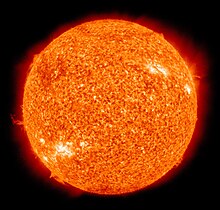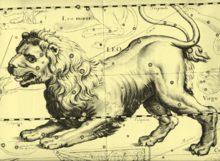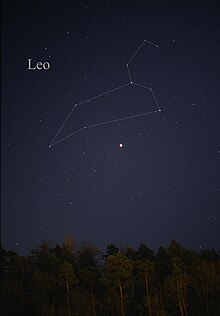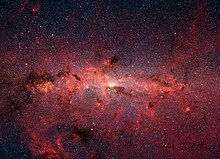
Stellar evolution of low-mass (left cycle) and high-mass (right cycle) stars, with examples in italics
Stars condense from regions of
space of higher matter density, yet those regions are less dense than within a
vacuum chamber. These regions—known as
molecular clouds—consist mostly of hydrogen, with about 23 to 28 percent helium and a few percent heavier elements. One example of such a star-forming region is the
Orion Nebula.
[61] Most stars form in groups of dozens to hundreds of thousands of stars.
[62] Massive stars in these groups may powerfully illuminate those clouds,
ionizing the hydrogen, and creating
H II regions. Such feedback effects, from star formation, may ultimately disrupt the cloud and prevent further star formation.
All stars spend the majority of their existence as
main sequence stars, fueled primarily by the nuclear fusion of hydrogen into helium within their cores. However, stars of different masses have markedly different properties at various stages of their development. The ultimate fate of more massive stars differs from that of less massive stars, as do their luminosities and the impact they have on their environment. Accordingly, astronomers often group stars by their mass:
[63]
- Very low mass stars, with masses below 0.5 M☉, are fully convective and distribute helium evenly throughout the whole star while on the main sequence. Therefore, they never undergo shell burning, never become red giants, which cease fusing and become helium white dwarfs and slowly cool after exhausting their hydrogen.[64] However, as the lifetime of 0.5 M☉ stars is longer than the age of the universe, no such star has yet reached the white dwarf stage.
- Low mass stars (including the Sun), with a mass between 0.5 M☉ and 1.8–2.5 M☉ depending on composition, do become red giants as their core hydrogen is depleted and they begin to burn helium in core in a helium flash; they develop a degenerate carbon-oxygen core later on the asymptotic giant branch; they finally blow off their outer shell as a planetary nebula and leave behind their core in the form of a white dwarf.
- Intermediate-mass stars, between 1.8–2.5 M☉ and 5–10 M☉, pass through evolutionary stages similar to low mass stars, but after a relatively short period on the red giant branch they ignite helium without a flash and spend an extended period in the red clump before forming a degenerate carbon-oxygen core.
- Massive stars generally have a minimum mass of 7–10 M☉ (possibly as low as 5–6 M☉). After exhausting the hydrogen at the core these stars become supergiants and go on to fuse elements heavier than helium. They end their lives when their cores collapse and they explode as supernovae.
Star formation
The formation of a star begins with gravitational instability within a molecular cloud, caused by regions of higher density—often triggered by compression of clouds by radiation from massive stars, expanding bubbles in the interstellar medium, the collision of different molecular clouds, or the
collision of galaxies (as in a
starburst galaxy).
[65][66] When a region reaches a sufficient density of matter to satisfy the criteria for
Jeans instability, it begins to collapse under its own gravitational force.
[67]
As the cloud collapses, individual conglomerations of dense dust and gas form "
Bok globules". As a globule collapses and the density increases, the gravitational energy converts into heat and the temperature rises. When the protostellar cloud has approximately reached the stable condition of
hydrostatic equilibrium, a
protostar forms at the core.
[68] These
pre-main-sequence stars are often surrounded by a
protoplanetary disk and powered mainly by the conversion of gravitational energy. The period of gravitational contraction lasts about 10 to 15 million years.
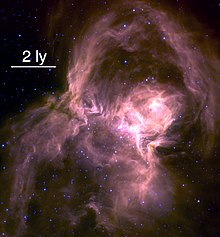
A cluster of approximately 500 young stars lies within the nearby
W40 stellar nursery.
Early stars of less than 2
M☉ are called
T Tauri stars, while those with greater mass are
Herbig Ae/Be stars. These newly formed stars emit jets of gas along their axis of rotation, which may reduce the
angular momentum of the collapsing star and result in small patches of nebulosity known as
Herbig–Haro objects.
[69][70] These jets, in combination with radiation from nearby massive stars, may help to drive away the surrounding cloud from which the star was formed.
[71]
Early in their development, T Tauri stars follow the
Hayashi track—they contract and decrease in luminosity while remaining at roughly the same temperature. Less massive T Tauri stars follow this track to the main sequence, while more massive stars turn onto the
Henyey track.
Most stars are observed to be members of binary star systems, and the properties of those binaries are the result of the conditions in which they formed.
[72] A gas cloud must lose its angular momentum in order to collapse and form a star. The fragmentation of the cloud into multiple stars distributes some of that angular momentum. The primordial binaries transfer some angular momentum by gravitational interactions during close encounters with other stars in young stellar clusters. These interactions tend to split apart more widely separated (soft) binaries while causing hard binaries to become more tightly bound. This produces the separation of binaries into their two observed populations distributions.
Main sequence
Stars spend about 90% of their existence fusing hydrogen into helium in high-temperature and high-pressure reactions near the core. Such stars are said to be on the
main sequence, and are called dwarf stars. Starting at zero-age main sequence, the proportion of helium in a star's core will steadily increase, the rate of nuclear fusion at the core will slowly increase, as will the star's temperature and luminosity.
[73] The Sun, for example, is estimated to have increased in luminosity by about 40% since it reached the main sequence 4.6 billion (4.6 × 10
9) years ago.
[74]
Every star generates a
stellar wind of particles that causes a continual outflow of gas into space. For most stars, the mass lost is negligible. The Sun loses 10
−14 M☉ every year,
[75] or about 0.01% of its total mass over its entire lifespan. However, very massive stars can lose 10
−7 to 10
−5 M☉ each year, significantly affecting their evolution.
[76] Stars that begin with more than 50
M☉ can lose over half their total mass while on the main sequence.
[77]
The time a star spends on the main sequence depends primarily on the amount of fuel it has and the rate at which it fuses it. The Sun is expected to live 10 billion (10
10) years. Massive stars consume their fuel very rapidly and are short-lived. Low mass stars consume their fuel very slowly. Stars less massive than 0.25
M☉, called
red dwarfs, are able to fuse nearly all of their mass while stars of about 1
M☉ can only fuse about 10% of their mass. The combination of their slow fuel-consumption and relatively large usable fuel supply allows low mass stars to last about one trillion (10
12) years; the most extreme of 0.08
M☉) will last for about 12 trillion years. Red dwarfs become
hotter and more luminous as they accumulate helium. When they eventually run out of hydrogen, they contract into a white dwarf and decline in temperature.
[64] However, since the lifespan of such stars is greater than the current
age of the universe (13.8 billion years), no stars under about 0.85
M☉[78] are expected to have moved off the main sequence.
Besides mass, the elements heavier than helium can play a significant role in the evolution of stars. Astronomers label all elements heavier than helium "metals", and call the chemical
concentration of these elements in a star, its
metallicity. A star's metallicity can influence the time the star takes to burn its fuel, and controls the formation of its magnetic fields,
[79] which affects the strength of its stellar wind.
[80] Older,
population II stars have substantially less metallicity than the younger, population I stars due to the composition of the molecular clouds from which they formed. Over time, such clouds become increasingly enriched in heavier elements as older stars die and shed portions of their
atmospheres.
Post–main sequence
As stars of at least 0.4
M☉[4] exhaust their supply of hydrogen at their core, they start to fuse hydrogen in a shell outside the helium core. Their outer layers expand and cool greatly as they form a
red giant. In about 5 billion years, when the Sun enters the helium burning phase, it will expand to a maximum radius of roughly 1
astronomical unit (150 million kilometres), 250 times its present size, and lose 30% of its current mass.
[74][81]
As the hydrogen shell burning produces more helium, the core increases in mass and temperature. In a red giant of up to 2.25
M☉, the mass of the helium core becomes degenerate prior to
helium fusion. Finally, when the temperature increases sufficiently, helium fusion begins explosively in what is called a
helium flash, and the star rapidly shrinks in radius, increases its surface temperature, and moves to the
horizontal branch of the HR diagram. For more massive stars, helium core fusion starts before the core becomes degenerate, and the star spends some time in the
red clump, slowly burning helium, before the outer convective envelope collapses and the star then moves to the horizontal branch.
[6]
After the star has fused the helium of its core, the carbon product fuses producing a hot core with an outer shell of fusing helium. The star then follows an evolutionary path called the
asymptotic giant branch (AGB) that parallels the other described red giant phase, but with a higher luminosity. The more massive AGB stars may undergo a brief period of carbon fusion before the core becomes degenerate.
Massive stars
During their helium-burning phase, a star of more than 9 solar masses expands to form first a
blue and then a
red supergiant. Particularly massive stars may evolve to a
Wolf-Rayet star, characterised by spectra dominated by emission lines of elements heavier than hydrogen, which have reached the surface due to strong convection and intense mass loss.
When helium is exhausted at the core of a massive star, the core contracts and the temperature and pressure rises enough to fuse
carbon (see
Carbon-burning process). This process continues, with the successive stages being fueled by
neon (see
neon-burning process),
oxygen (see
oxygen-burning process), and
silicon (see
silicon-burning process). Near the end of the star's life, fusion continues along a series of onion-layer shells within a massive star. Each shell fuses a different element, with the outermost shell fusing hydrogen; the next shell fusing helium, and so forth.
[82]
The final stage occurs when a massive star begins producing
iron. Since iron nuclei are more
tightly bound than any heavier nuclei, any fusion beyond iron does not produce a net release of energy. To a very limited degree such a process proceeds, but it consumes energy. Likewise, since they are more tightly bound than all lighter nuclei, such energy cannot be released by
fission.
[83]
Collapse
As a star's core shrinks, the intensity of radiation from that surface increases, creating such
radiation pressure on the outer shell of gas that it will push those layers away, forming a
planetary nebula. If what remains after the outer atmosphere has been shed is less than 1.4
M☉, it shrinks to a relatively tiny object about the size of Earth, known as a
white dwarf. White dwarfs lack the mass for further gravitational compression to take place.
[84] The
electron-degenerate matter inside a white dwarf is no longer a plasma, even though stars are generally referred to as being spheres of plasma. Eventually, white dwarfs fade into
black dwarfs over a very long period of time.
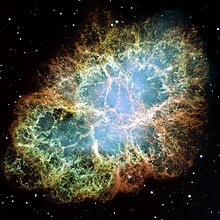
The
Crab Nebula, remnants of a supernova that was first observed around 1050 AD
In massive stars, fusion continues until the iron core has grown so large (more than 1.4
M☉) that it can no longer support its own mass. This core will suddenly collapse as its electrons are driven into its protons, forming neutrons, neutrinos, and gamma rays in a burst of
electron capture and
inverse beta decay. The
shockwave formed by this sudden collapse causes the rest of the star to explode in a supernova. Supernovae become so bright that they may briefly outshine the star's entire home galaxy. When they occur within the Milky Way, supernovae have historically been observed by naked-eye observers as "new stars" where none seemingly existed before.
[85]
A supernova explosion blows away the star's outer layers, leaving a
remnant such as the Crab Nebula.
[85] The core is compressed into a
neutron star, which sometimes manifests itself as a
pulsar or
X-ray burster. In the case of the largest stars, the remnant is a black hole greater than 4
M☉.
[86] In a neutron star the matter is in a state known as
neutron-degenerate matter, with a more exotic form of degenerate matter,
QCD matter, possibly present in the core. Within a black hole, the matter is in a state that is not currently understood.
The blown-off outer layers of dying stars include heavy elements, which may be recycled during the formation of new stars. These heavy elements allow the formation of rocky planets. The outflow from supernovae and the stellar wind of large stars play an important part in shaping the interstellar medium.
[85]
Binary stars
The post–main-sequence evolution of binary stars may be significantly different from the evolution of single stars of the same mass. If stars in a binary system are sufficiently close, when one of the stars expands to become a red giant it may overflow its
Roche lobe, the region around a star where material is gravitationally bound to that star, leading to transfer of material to the other. When the Roche lobe is violated, a variety of phenomena can result, including
contact binaries,
common-envelope binaries,
cataclysmic variables, and
type Ia supernovae.

